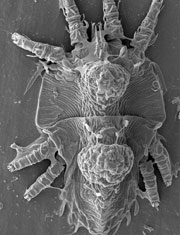About flat mites
Systematics & taxonomy
 Flat mites* (Acari: Trombidiformes: Tetranychoidea: Tenuipalpidae) range from 0.25 to 0.4 mm in size, with a diversity of body shapes from round, elongate, pyriform, ovoid, triangular in cross-section with either a flat venter or flat dorsum, to paper-thin. The group varies a great deal in color also, with variations on red being the most common; however the discovery of many new species from Asia, Africa and Australia has revealed much more diversity in color variation from yellow, orange, green, to brown.
Flat mites* (Acari: Trombidiformes: Tetranychoidea: Tenuipalpidae) range from 0.25 to 0.4 mm in size, with a diversity of body shapes from round, elongate, pyriform, ovoid, triangular in cross-section with either a flat venter or flat dorsum, to paper-thin. The group varies a great deal in color also, with variations on red being the most common; however the discovery of many new species from Asia, Africa and Australia has revealed much more diversity in color variation from yellow, orange, green, to brown.
The world fauna has been variously treated on several occasions (Pritchard & Baker 1951, 1958; Mitrofanov 1973a, 1973b; Meyer 1979; Mesa et al. 2009 – see reference page for details), but the information available lacks resolution. For example, the three most important species in the family world-wide, Brevipalpus californicus, B. obovatus and B. phoenicis are still consistently confused and misidentified. The genus Brevipalpus is the most commonly intercepted genus of Tenuipalpidae in quarantine world-wide, but it is also the most complicated and by far the most diverse genus in the family.
* also referred to as false spider mites, in reference to the related family of spider mites, Tetranychidae.
Diversity
The family Tenuipalpidae has a worldwide distribution with over 1100 valid species belonging to 38 genera. Most species have been described from North America (33% of the total known flat mite fauna) and Africa (13%), whereas little is known about flat mites in the rest of the world (Mesa et al. 2009).

